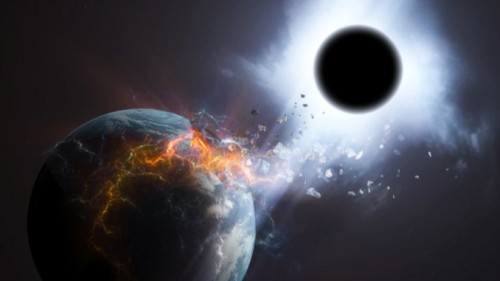But given their talent for consumption, why don't black holes just keep expanding and expanding and simply swallow the Universe? In 2018, one of the world's top physicists came up with a dazzling explanation.
Conveniently, the idea could also unite the two biggest theories in all of physics.
The researcher behind this explanation is none other than Stanford University physicist Leonard Susskind, also known as one of the fathers of string theory.
He gave his two cents on the paradox in a series of papers, which basically suggest that black holes expand by increasing in complexity inwardly – a feature we just don't see connected while watching from afar.
In other words, they expand in, not out.
Weirder still, this hypothesis might have a parallel in the expansion of our own Universe, which also seems to be growing in a counterintuitive way.
"I think it's a very, very interesting question whether the cosmological growth of space is connected to the growth of some kind of complexity," Susskind was quoted in The Atlantic.
"And whether the cosmic clock, the evolution of the Universe, is connected with the evolution of complexity. There, I don't know the answer."
Susskind might be speculating on the Universe's evolution, but his thoughts on why black holes grow in more than they do out is worth unpacking. Of course, by its very nature, this type of research is theoretical, and not easily verified or disproved through the process of peer review.
But there are some pretty cool idea in here worth unpacking. To do that, we need to go back to basics for a moment. So... hang tight.
Put simply, black holes are dense masses that distort space to the extent that even light (read: information) lacks the escape velocity required to make an exit.
The first solid theoretical underpinnings for such an object emerged naturally out of the mathematics behind Einstein's general relativity back in 1915. Since then, physical objects matching those predictions have been spotted, often hanging around the centers of galaxies.
A common analogy is to imagine the dimensions of space plus time as a smooth rubber sheet. Much as a heavy object dimples the rubber sheet, mass distorts the geometry of spacetime.
The properties of our Universe's rubber sheet means it can form a deep gravity funnel that stretches 'down' without stretching much further 'out'.
Most objects expand 'out' as you add material, not 'in'. So how do we even begin to picture this? Rubber sheets are useful analogies, but only up to a certain point.
To understand how matter behaves against this super stretchy backdrop, we need to look elsewhere. Luckily, physics has a second rule book on how the Universe works called quantum mechanics, which describes how particles and their forces interact.
The two rule books of general relativity and quantum mechanics don't always agree, though. Small things interpreted through the lens of general relativity don't make much sense. And big things like black holes produce gibberish when the rules of quantum mechanics are applied.
This means we're missing something important – something that would allow us to interpret general relativity's space-bending feature in terms of finite masses and force-mediating particles.
One contender is something called anti-de Sitter/conformal field theory correspondence, shortened to Ads/CFT. This is a 'string theory meets four-dimensional space' kind of idea, aiming to bring the best of both quantum mechanics and general relativity together.
Based on its framework, the quantum complexity of a black hole – the number of steps required to return it to a pre-black hole state – is reflected in its volume.
The same thinking is what lies behind another brain-breaking idea called the holographic principle. The exact details aren't for the faint-hearted, but remain freely available on arXiv if you want to get your mathematics fix for the day.
It might sound a bit like downloading movies onto your desktop only to find it's now 'bigger' on the inside. As ludicrous as it sounds, in the extreme environment of a black hole more computational power might indeed mean more internal volume. At least this is what Susskind's Ads/CFT modelling suggests.
String theory itself is one of those nice ideas begging for an empirical win, so we're still a long way from marrying quantum mechanics and general relativity.
Susskind's suggestion that quantum complexity is ultimately responsible for the volume of a black hole has physicists thinking through the repercussions. After all, black holes aren't like ordinary space, so we can't expect ordinary rules to apply.

Black holes are great at sucking up matter. So great, in fact, that not even light can escape their grasp (hence the name).




